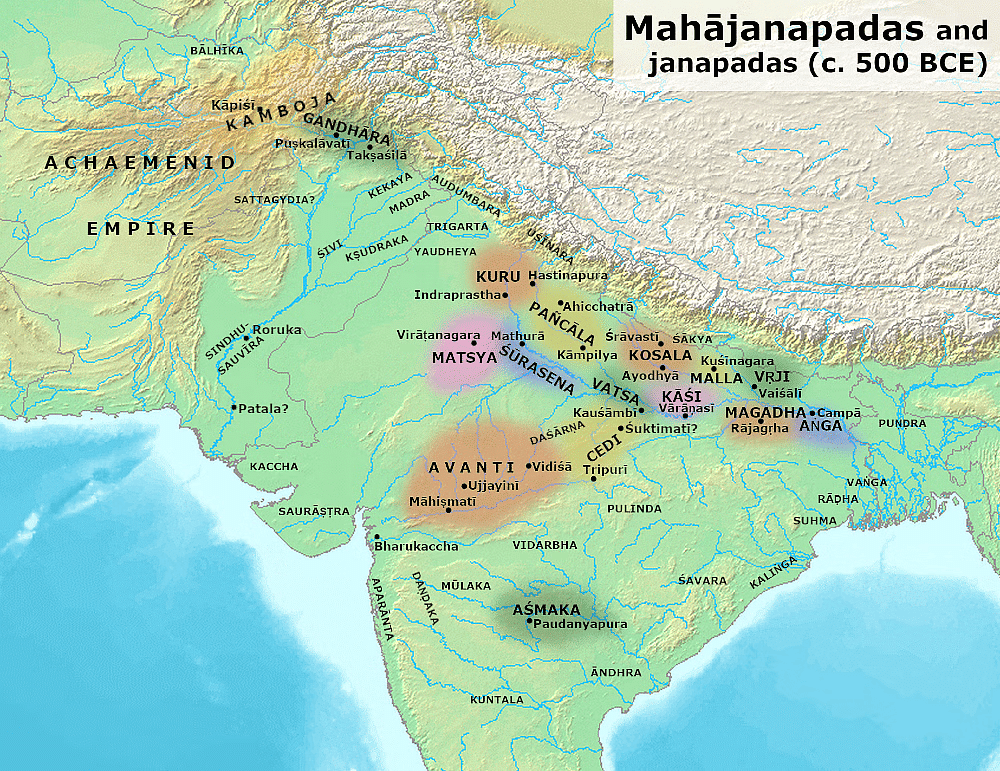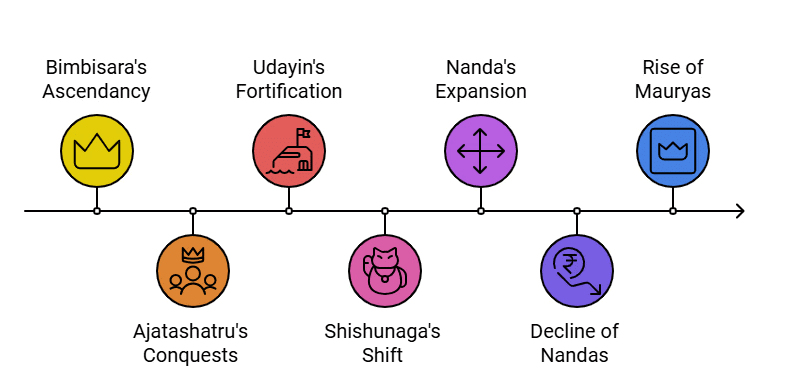Old NCERT Summary (RS Sharma): Territorial States & The First Magadhan Empire | History for UPSC CSE PDF Download
| Table of contents |

|
| Introduction |

|
| The Mahajanapadas |

|
| Rise and Growth of the Magadha Empire |

|
| Causes of Magadha's Success |

|
Introduction
From the sixth century B.C., the widespread use of iron in eastern Uttar Pradesh and western Bihar led to the formation of large territorial states. The adoption of iron weapons and new agricultural tools empowered the warrior class and increased food production. The surplus was used by princes for military and administrative needs and also benefited emerging towns. This development reinforced the territorial concept, with people pledging allegianceto their Janapadas or territory rather than the broader Jana to which they belonged.
The Mahajanapadas

Mahajanapadas in the Buddha's Age:
- 16 large states called Mahajanapadas existed in the age of the Buddha.
- Mostly situated north of the Vindhyas and extending from the north-west frontier to Bihar.
Powerful States:
- Notable powerful states included Magadha, Koshala, Vatsa, and Avanti.
- Magadha emerged as the leading state, encompassing districts like Patna, Gaya, and parts of Shahbad.
Kingdom of Anga:
- The Kingdom of Anga covered the modern districts of Monghyr and Bhagalpur.
- Capital: Champa.
- Absorbed by the powerful neighbour, Magadha.
State of Vajjis:
- North of the Ganga, in the division of Tirhut.
- Included eight clans, with the Lichchhavis being the most powerful.
- Capital: Vaishali (Basarh).
Kingdom of Kashi:
- Capital: Varanasi.
- Initially powerful but eventually submitted to Koshala.
Koshala:
- Embraced eastern Uttar Pradesh.
- Capital: Shravasti (Sahet-Mahet on the borders of Gonda and Bahraich districts).
- Important city: Ayodhya, associated with the Ramayana.
- Included the tribal republican territory of the Shakyas (Kapilvastu, Piprahwa, and Lumbini).
Mallas:
- Neighboring Koshala, with a capital at Kushinara (Kasia in the Deoria district).
- Place of Gautama Buddha's passing away.
Vatsas:
- Kingdom along the bank of the Yamuna.
- Capital: Kaushambi (near Allahabad).
- Originated from the Kuru clan, formerly at Hastinapur.
Kurus and Panchalas:
- Older states in western Uttar Pradesh, diminishing in political importance.
Avantis:
- State in central Malwa and adjoining parts of Madhya Pradesh.
- Divided into northern part (capital: Ujjain) and southern part (capital: Mahishamati).
Rise and Growth of the Magadha Empire

Magadha under Bimbisara:
- Bimbisara of the Haryanka dynasty brought Magadha into prominence.
- Contemporary of Buddha.
- Initiated a policy of conquest and aggression.
- Acquired Anga and appointed his son Ajatashatru as its viceroy at Champa.
- Strengthened position through strategic marriage alliances.
Rivalries and Alliances:
- Avanti with capital at Ujjain was a serious rival initially.
- King Chanda Pradyota Mahasena fought Bimbisara but they later became friends.
- Ajatashatru succeeded Bimbisara (544 B.C. to 492 B.C.) and faced conflicts with Kashi and Koshala.
- Engaged in prolonged conflict with Koshala and emerged victorious, gaining control of Kashi.
Expansion and Conquests:
- Ajatas Hatru waged war against Vaishali(Lichchhavis).
- Used advanced war tactics, including a war engine and a mace-attached chariot.
- Expanded the Magadhan empire by adding Kashiand Vaishali.
Dynastic Shifts:
- Udayin succeeded Ajatas Hatru (460-444 B.C.) and fortified Rajgir.
- Dynasty of Shishunagas succeeded, temporarily shifting the capital to Vaishali.
- Destroyed the power of Avanti, ending the century-old rivalry.
Nandas:
- Nandas succeeded the Shishunagas and proved powerful rulers.
- During the reign of Mahapadma Nanda, Magadhan's power expanded by conquering Kalinga.
- Alexander, invading Punjab, did not advance eastward due to the Nandas' power.
- Mahapadma Nanda claimed to be the sole sovereign who destroyed other ruling princes.
- Acquired Koshala in addition to Kalinga.
Decline of Nandas and Rise of Mauryas:
- Later Nandas were weak and unpopular, leading to the rise of the Maurya dynasty.
- The Mauryan empire reached its apex of glory under the rule of the Mauryas.
Causes of Magadha's Success
The march of the Magadhan empire during the two centuries preceding the rise of the Mauryas is similar to the Iranian expansion during the same period. The formation of the largest state in India during this period was the work of several enterprising and ambitious rulers such as Bimbisara, Ajatashatru, and Mahapadma Nanda. They employed all means, fair and foul, at their disposal to enlarge their kingdoms and strengthen their positions. But this was not the only reason for the expansion of Magadha.

There were some important factors:
Geographical Advantage:
- Magadha had an advantageous geographical position with rich iron deposits near Rajgir, its earliest capital.
- Ready availability of iron facilitated the Magadhan princes in equipping their armies with superior weapons, giving them an edge over rivals.
- Iron deposits were also found in eastern Madhya Pradesh, close to the kingdom of Avantis with its capital at Ujjain, making them a significant competitor.
Strategic Capitals:
- Magadha had two strategic capitals: Rajgir and later Pataliputra.
- Rajgir, surrounded by five hills, was considered impregnable in ancient times.
- Pataliputra, located at the confluence of the Ganga, Gandak, and Son rivers, held a pivotal position commanding communications on all sides.
Agricultural Fertility:
- Magadha, at the center of the middle Gangetic plain, had immensely fertile alluvial soil.
- Abundant rainfall made the area highly productive, supporting the cultivation of various crops, particularly paddy.
Economic Prosperity:
- Rise of towns and the use of coins contributed to Magadha's economic prosperity.
- Trade and commerce in northern India allowed Magadhan princes to levy tolls on the movement of commodities, accumulating wealth for the maintenance of their armies.
Military Innovation:
- Magadha pioneered the use of elephants on a large scale in warfare against neighboring states.
- The eastern part of the country provided a steady supply of elephants, which were instrumental in storming fortresses and navigating challenging terrains.
Unorthodox Social Structure:
- Magadha had a unique social composition, inhabited by Kiratas and Magadhas who were initially looked down upon by orthodox Brahmanas.
- The population underwent a racial admixture with the arrival of the Vedic people, contributing to a society that showed more enthusiasm for expansion.
Magadha's expansion was propelled by geographical advantages, strategic capitals, agricultural fertility, economic prosperity, military innovation, and a unique social structure, ultimately leading to the establishment of the first empire in India.
|
210 videos|839 docs|219 tests
|
FAQs on Old NCERT Summary (RS Sharma): Territorial States & The First Magadhan Empire - History for UPSC CSE
| 1. What were the Mahajanapadas and how did they contribute to the rise of the Magadha Empire? |  |
| 2. What factors led to the success of the Magadha Empire? |  |
| 3. How did the Magadha Empire become the first major empire in ancient India? |  |
| 4. What role did the territory of Magadha play in its rise as an empire? |  |
| 5. How did the Magadha Empire promote trade and commerce? |  |





















